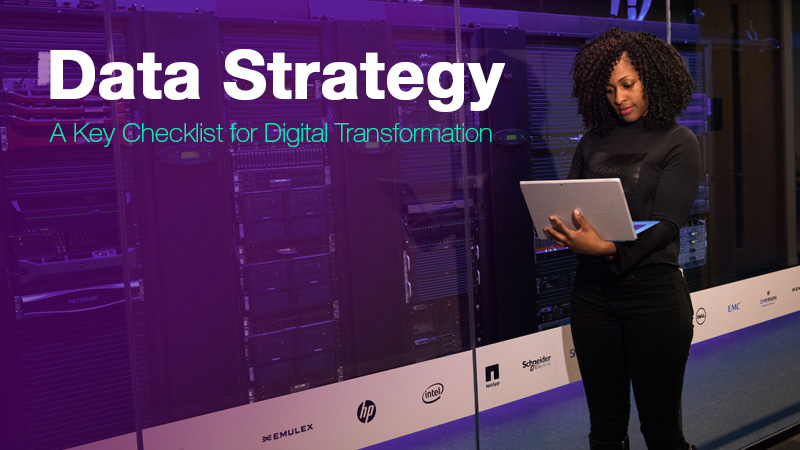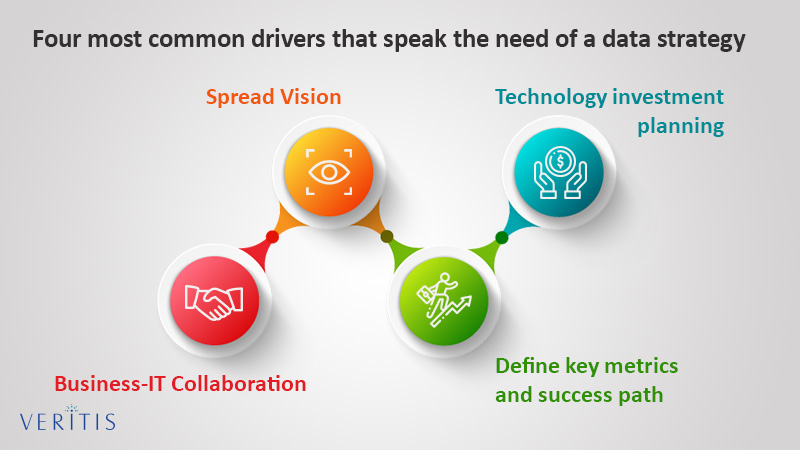
Data is today’s buzzword and tomorrow’s most powerful tool! This is a fact heard everywhere, regardless of industry. The digital revolution has set a growth trajectory for data, both currently and in the future. Data has become so significant that experts consider it an integral part of the digital future.
While practical data usage can help a business gain a competitive edge, data harnessing is at the core of a competitive business model. Modern industry calls ‘data’ an asset with high saleable value and essential for day-to-day processes.
Digitally Transform Your Business
Data Strategy for DX Implementation
A well-defined data strategy aligned with digitalization efforts forms a strong basis for the successful Digital Transformation process. It is a key checklist for developing a practical roadmap for DX implementation, which companies pursue as part of their IT modernization.
An effective data strategy, often supported by enterprise data management consulting, defines an organization’s path to treating its data as a structured, cross-domain asset that generates vast business value. It plays a key role in setting a DX vision and offers guidance and well-defined key performance indicators that help evaluate and rationalize all related data initiatives.”
The four most common drivers that speak of the need for a data strategy include:

1) Business-IT Collaboration
Drive core business objectives and IT perspectives onto a single path, thus encouraging a business-led and technology-enabled approach internally and externally.
2) Spread Vision
Take forward the vision across the enterprise, bringing perfect alignment and consistency among teams, reducing operational costs, and optimizing performance.
3) Define key metrics and the success path
Consistency positively impacts key metrics and lays the foundation for measuring, evaluating, and tracking initiatives across the process chain.
4) Technology investment planning
Investing in legacy technologies might not be appropriate for your new setup. At this point, a strategy considers the current state of your enterprise data environments and guides you accordingly on innovation and new technology investment.
Useful link: Digital Transformation: Avoid 8 Most Common Pitfalls
Creating an Effective Data Strategy

Implementing an Enterprise Data Strategy involves a stepwise approach. It begins with defining the scope and proceeds through planning and implementation.
Defining the scope for an effective data strategy involves:
- Assessment and review of the existing analytic capabilities
- Mapping data flow within the organization
- Reviewing capabilities of the existing data management program
- Documenting useful data requirements
- Identifying the best enterprise data management solutions
- Developing a roadmap by defining initiatives in coordination with key stakeholders
Next comes the planning and implementation, where organizations will need to:
- Update the existing data management program through a well-planned approach
- Schedule a phase-wise implementation of the roadmap to meet the organizational needs to fit in the future program
- Bring in expertise to identify challenges to highlight and manage risk associated with the process
- Reach an agreement with the stakeholders on initiatives identified in the scope phase
On the opposite side, it’s equally important to consider the following factors that challenge the implementation of a comprehensive data strategy:
- Information access is key to planning an effective data strategy. A lack of access to information can lead to serious issues with data integrity.
- Data governance is another key factor, and a lack of it naturally leads to a lack of agility in delivering projects on time and accurately.
- Another problem is a lack of archiving strategy, which leads to data maintenance challenges and affects data retention and performance.
- Data storage is another critical aspect that obstructs organizational strengths to develop future capabilities.
Implementing the steps above and procedures eliminates the technical and functional gaps between the organization’s existing and future-state data management program through enterprise data management services.
Case Study: A Holistic Approach to Digital Transformation in Healthcare
A leading healthcare provider partnered with Veritis, a trusted digital transformation partner, to leverage AWS for a comprehensive digital transformation. Veritis’s expertise in cloud solutions and knowledge of the healthcare industry was instrumental in this collaboration, enabling the organization to modernize its infrastructure, streamline operations, and enhance patient care through improved data management and advanced analytics.
Challenge:
The healthcare provider faced multiple challenges in their digital transformation journey. Their data was fragmented across various systems, such as patient records, billing, and inventory, leading to inefficiencies and delays in accessing critical information. The lack of integration between departments, including clinical, administrative, and support services, further hindered collaboration and the smooth flow of data. Moreover, the organization struggled to fully utilize its data for predictive analytics, limiting its ability to make data-driven decisions and improve patient outcomes.
Solution:
Veritis developed and executed a cloud-first approach utilizing AWS to tackle these challenges. This approach involved transitioning the organization’s infrastructure to AWS, offering improved scalability, security, and cost-effectiveness. For example, AWS’s machine learning tools were employed to forecast patient outcomes and tailor treatment plans. Furthermore, Veritis streamlined data integration across systems, ensuring smooth access and enhanced interoperability. By incorporating AI and ML technologies, Veritis enabled the healthcare provider to harness predictive analytics, significantly boosting both clinical and operational decision-making.
Results:
- Streamlined Operations: Centralizing data and automating workflows reduced inefficiencies across departments.
- Improved Decision-Making: The introduction of AI and ML capabilities not only enabled data-driven insights but also empowered healthcare providers with the potential for better patient care and operational efficiency.
- Scalable Infrastructure: The AWS platform not only provided a flexible and scalable solution but also demonstrated the organization’s adaptability in supporting its growing needs.
This case study highlights the impact of AWS in driving healthcare digital transformation, demonstrating how strategic cloud adoption and data integration can significantly improve patient care and operational performance.
Read the full success story: A Holistic Approach to Digital Transformation in Healthcare.